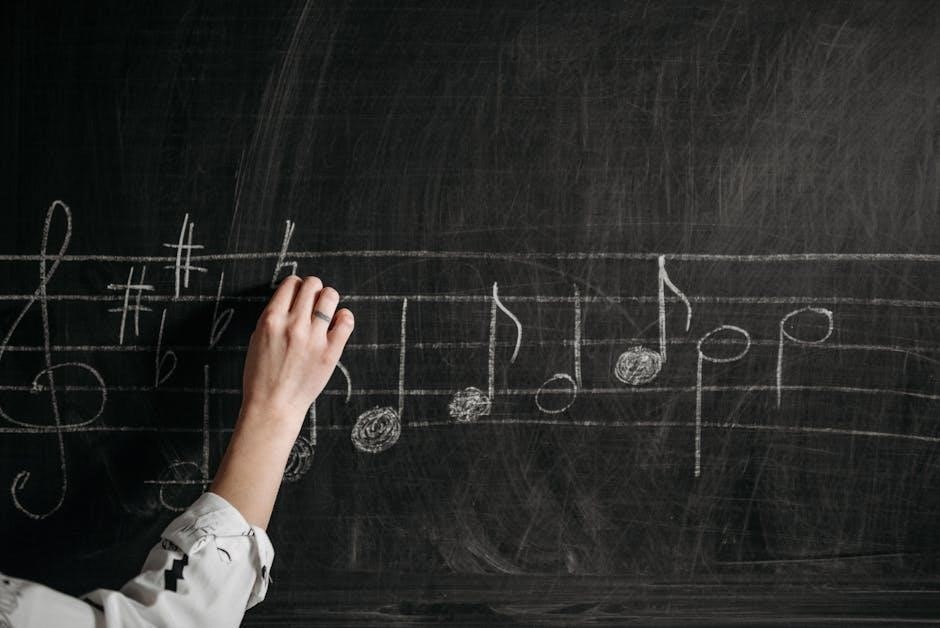
Music writing is a universal language bridging creativity and technicality, enabling precise expression of pitches, rhythms, and harmonies. It empowers composers, performers, and analysts to convey complex ideas and emotions clearly. This guide provides a comprehensive introduction to music writing, covering fundamental notation, theory, and practical techniques to enhance musical communication and expression.

Fundamentals of Music Notation
Fundamentals of music notation include the staff, clefs, note values, rests, time signatures, ledger lines, and accidentals. These elements collectively convey pitch, rhythm, and musical instructions, essential for reading and writing music effectively.
The Musical Staff
The musical staff is the foundation of written music, consisting of five horizontal lines and four spaces. Each line and space represents a specific pitch, allowing for precise notation. Clefs, placed at the beginning of the staff, indicate the pitch range and notation system. The treble clef (G clef) is commonly used for higher-pitched instruments, while the bass clef (F clef) is used for lower-pitched instruments. Note heads, positioned on the lines or spaces, determine pitch, with stems indicating rhythm. Ledger lines extend beyond the staff to accommodate pitches outside the standard range. Accidentals, such as sharps, flats, and naturals, modify pitch for nuanced expression. Mastering the staff, clefs, and ledger lines is essential for reading and composing music effectively, as they form the visual language of musical communication. This system ensures clarity and precision in conveying musical ideas, making it indispensable for composers and performers alike.
Clefs
Clefs are essential symbols in music notation that indicate the pitch range and notation system for a specific instrument or vocal part. The most common clefs are the treble clef (G clef) and the bass clef (F clef). The treble clef is used for higher-pitched instruments, such as violins, flutes, and soprano voices, while the bass clef is used for lower-pitched instruments, like cellos, bassoons, and baritones. Other clefs, such as the alto clef (used by violas) and tenor clef (used by trombones and cellos), are less common but serve specific roles. Clefs are placed at the beginning of the staff and determine the pitch of each line and space. They provide a visual cue for musicians to interpret the correct pitches, ensuring accurate performance. Understanding clefs is fundamental for reading and writing music, as they establish the tonal foundation of a composition.

Note Values and Rests
Note values and rests are fundamental elements in music notation, defining the duration of sounds and silences. A whole note, represented by an open circle, lasts for four beats in 4/4 time, while a half note, with an open circle and a stem, lasts for two beats. A quarter note, a closed circle with a stem, lasts for one beat, and an eighth note, with a flag, lasts for half a beat. Rests, which indicate silence, mirror the durations of notes: whole, half, quarter, and eighth rests. A dot after a note increases its duration by half, and beams group notes together for clarity. Understanding these elements is crucial for interpreting rhythm and timing accurately. Note values and rests form the foundation of rhythmic notation, enabling precise communication of musical timing and articulation. They are essential for both reading and writing musical scores effectively.
Time Signatures
Time signatures are a crucial element in music notation, defining the rhythmic structure of a composition. Consisting of two numbers, the top number indicates the number of beats per measure, while the bottom number specifies the type of note that receives one beat. For example, in 4/4 time, there are four beats per measure, with each quarter note receiving one beat. Common time signatures like 3/4 (waltz time) and 2/4 (march time) dictate the rhythmic framework of a piece. Rhythmic notation, including dots, beams, and rests, further refines the timing. A dot after a note extends its duration by half, while beams group notes for clarity. Rests, which represent silence, mirror the durations of notes. Mastering time signatures and rhythmic notation is essential for interpreting a composition’s timing and articulation accurately, ensuring the intended musical feel is conveyed effectively. This understanding is vital for both performers and composers to communicate musical ideas with precision.
Ledger Lines
Ledger lines are essential for extending the musical staff to accommodate pitches beyond its standard range. These short lines, placed above or below the staff, allow notation of higher or lower pitches. Each ledger line represents a specific pitch, with spaces between them indicating intervals. Note heads on ledger lines function like those on the staff, with their position determining pitch. Open note heads (hollow) and closed note heads (filled) differentiate between whole and half steps. Stems and flags on ledger lines indicate rhythm, similar to notes on the staff. Accidentals can modify pitches on ledger lines, ensuring precise interpretation. Mastering ledger lines is crucial for reading and writing music, as they expand the staff’s range and enable accurate communication of musical ideas. This foundational element bridges the gap between standard notation and extended pitch expression, making it indispensable for composers and performers alike.

Accidentals

Accidentals—sharps (#), flats (♭), and naturals (♮)—modify a note’s pitch, adding nuance to melodies and harmonies. Sharps raise a note by a half step, while flats lower it. Naturals cancel prior sharps or flats, restoring the note to its natural pitch. Accidentals appear directly before the affected note or within key signatures, ensuring precise interpretation. Their placement is crucial for conveying the composer’s intent, as they alter the tonal color and emotional impact of a piece. Understanding accidentals is vital for accurate musical expression, as they refine pitches and enhance the complexity of musical structures. Whether in notation or performance, accidentals are indispensable for capturing the subtleties of sound, making them a cornerstone of effective music writing and interpretation.
Core Music Theory
Core music theory encompasses scales, key signatures, chords, and harmonization, forming the foundation for composition and analysis. These elements provide the tools to create and interpret musical structures effectively and expressively.
Scales
Scales are the foundational building blocks of music, consisting of a series of notes arranged in ascending or descending order within an octave. Major and minor scales are the most commonly used, each with distinct emotional connotations. A major scale follows the interval pattern of whole, whole, half, whole, whole, whole, and half steps, creating a bright and uplifting sound. Minor scales, including natural, harmonic, and melodic forms, produce a moodier and more somber atmosphere due to their differing interval structures. Understanding scales is essential for composition and analysis, as they form the basis of melodies and harmonies. Key signatures, derived from scales, indicate the tonal context of a piece. Mastering major and minor scales enhances a musician’s ability to create and interpret music effectively, providing a rich harmonic and melodic vocabulary. This foundation is critical for both personal expression and professional growth in music.
Key Signatures
Key signatures are a fundamental element in music notation, indicating the use of sharps or flats in a composition. Placed at the beginning of the staff, they provide a visual cue for musicians to adjust pitches accordingly, ensuring consistency across the piece. The key signature reflects the tonality of the music, whether major or minor, and helps establish the overall mood and harmonic structure. The significance of key signatures lies in their ability to convey the composer’s intent regarding pitch alterations. They eliminate the need for repeated accidentals, streamlining the notation and enhancing readability. Understanding key signatures is essential for performers to interpret the music correctly and for composers to express their artistic vision. By mastering key signatures, musicians can effectively navigate the harmonic landscape of a piece, ensuring accurate performance and expression of the intended musical feel.
Chords

Chords are a fundamental element in music, consisting of three or more pitches sounding simultaneously. They are built from scales and form the harmonic foundation of a composition. A basic chord, or triad, includes a root, a third, and a fifth. Major and minor chords are the most common, with major chords producing a bright, stable sound and minor chords creating a more somber, introspective feel. Chords can also be extended with additional notes, such as sevenths, ninths, and elevenths, to create more complex harmonies. Diminished and augmented chords alter the intervals between notes, adding tension and color to music. Understanding chords is essential for composition, improvisation, and analysis, as they define the harmonic structure and emotional impact of a piece. By mastering chord construction and progression, musicians can create rich, dynamic, and expressive musical landscapes, enhancing both personal and professional musical endeavors.
Harmonization
Harmonization is the process of combining a melody with chords and bass lines to create a cohesive musical texture. It adds depth, complexity, and emotional resonance to a composition. Effective harmonization involves understanding chord progressions, voice leading, and spacing to ensure smooth transitions between chords. Techniques such as doubling, suspension, and resolution are used to enhance harmonic richness. Harmonization can also incorporate non-chordal tones like passing tones and neighbor notes to add variety. The choice of harmonic structures, such as homophony or polyphony, significantly impacts the overall sound. Key signatures and chord progressions guide the harmonization process, ensuring consistency and coherence. By mastering harmonization, musicians can create balanced, engaging, and emotionally compelling music, making it a fundamental skill for composers, arrangers, and performers alike. This process is essential for transforming a simple melody into a fully realized musical work.

The Process of Writing Music
Writing music involves creating melodies, harmonies, and rhythms, structured into compositions. It requires inspiration, technical skill, and creativity to express emotions and ideas through sound, resulting in a polished musical piece.
Starting with a Melody
Starting with a melody is often the foundation of music writing, as it conveys the emotional core of a piece. A strong melody should be memorable, expressive, and aligned with the intended mood. Musicians typically begin by brainstorming melodic ideas, either through improvisation or deliberate composition. The melody’s pitch, rhythm, and contour are critical, as they determine how the listener perceives the music. Simplifying ideas and focusing on a central theme can help create a cohesive melody. Refining the melody involves experimenting with variations, ensuring it flows naturally, and aligning it with the harmonic and rhythmic structure. A well-crafted melody serves as the backbone of a composition, guiding the listener’s emotional journey and setting the stage for further development, such as harmonization and orchestration.

Developing Harmonies
Developing harmonies is a crucial step in music writing, as they add depth, texture, and emotional complexity to a composition. Harmonies are created by layering pitches above or below a melody, following the rules of music theory. Understanding scales, key signatures, and chord progressions is essential for crafting harmonies that resonate with the melody. A key signature dictates the tonal framework, guiding the selection of compatible chords and pitches. Musicians often experiment with different chord voicings and inversions to achieve the desired harmonic effect. Effective harmonies enhance the melody’s emotional impact while maintaining structural coherence. They can also introduce tension and resolution, adding dynamic interest to the music. By balancing consonance and dissonance, composers create a rich, engaging sound that elevates the overall piece. Harmonies are not just about complexity but about serving the music’s emotional and artistic intent.
Structuring Your Composition
Structuring your composition is essential for creating a cohesive and engaging musical piece. A well-defined structure guides the listener through the emotional and thematic journey of the music. Common forms include sonata form, verse-chorus, and ABA (ternary) structures, each providing a framework for organizing melodies, harmonies, and rhythms. The exposition introduces themes, while the development explores and transforms them. The recapitulation resolves these ideas, creating a sense of completion. Effective structure balances contrast and unity, ensuring variety while maintaining a coherent narrative. A strong melody supported by harmonic and rhythmic elements forms the backbone of the composition. Understanding these structural principles allows composers to craft music that resonates emotionally and intellectually with the audience. By organizing musical ideas thoughtfully, composers can convey their artistic vision with clarity and impact, making the composition both meaningful and memorable.
Using Rhythm and Tempo
Rhythm and tempo are fundamental elements in music writing, shaping the feel and emotional impact of a composition. Rhythm, defined by note values and rests, creates patterns that guide the listener’s perception of time. Time signatures, such as 4/4 or 3/4, establish the rhythmic framework, indicating how many beats are in a measure and which note value receives one beat. Note values (whole, half, quarter, eighth) and rests dictate durations, while dots and beams modify these values for complexity. Tempo, measured in beats per minute (BPM), determines the speed of the music, influencing its mood and energy. A faster tempo can create urgency, while a slower tempo may evoke reflection. Mastering rhythm and tempo ensures precise interpretation and expression, allowing composers to craft music that resonates with listeners. Balancing these elements is key to creating engaging and emotionally impactful compositions.

Lyrics and Text in Music
Lyrics and text in music convey emotions, tell stories, and connect with audiences. Effective lyric writing blends creativity with structure, while setting text to music requires sensitivity to rhythm and phrasing.
Writing Lyrics
Writing lyrics is a creative process that combines storytelling, emotional expression, and rhythmic phrasing. Effective lyrics often tell a story, evoke emotions, or convey a message, resonating with listeners on a personal level. A strong lyric structure typically includes verses, choruses, and bridges, each serving a distinct purpose. Verses narrate the story or idea, choruses provide the emotional peak and repetition, while bridges offer contrast and depth. Lyricists must balance creativity with technical aspects like rhythm, rhyme, and meter to ensure the words align with the music. Clarity and conciseness are key, as overly complex lyrics can lose their impact. Additionally, understanding the audience and the song’s purpose helps tailor the lyrics for maximum connection. By blending imagination with craftsmanship, lyricists can craft memorable and impactful words that enhance the musical experience.

Setting Text to Music
Setting text to music involves aligning words with melodies, rhythms, and harmonies to create a cohesive musical expression. This process requires a deep understanding of both the text’s meaning and the musical elements that will accompany it. The goal is to enhance the emotional impact of the lyrics while ensuring the music complements the text’s natural rhythm and meter. When setting text to music, it’s important to consider syllable placement, stress patterns, and the flow of language. The melody should support the text’s narrative or emotional intent, while harmony and rhythm provide depth and structure. Effective text setting balances musicality with clarity, ensuring the words remain intelligible and impactful. This skill is essential for songwriters, composers, and lyricists, as it transforms written ideas into a vivid auditory experience, connecting listeners with the message and emotion of the music.
Orchestration and Arrangement
Orchestration involves assigning sounds to instruments, while arrangement structures musical elements. Both processes enhance compositions, ensuring balance, texture, and emotional impact, transforming ideas into polished, engaging musical experiences.
Basic Orchestration
Basic orchestration involves assigning sounds to instruments to create balanced and engaging musical textures. It requires understanding each instrument’s range, timbre, and technical capabilities. Common instruments include strings (violins, cellos), woodwinds (flutes, clarinets), brass (trumpets, trombones), and percussion (drums, timpani). The goal is to distribute melodic, harmonic, and rhythmic elements effectively, ensuring clarity and emotional impact. For example, strings often carry melodies, while brass provides harmonic depth. Percussion adds rhythm and accents. Proper orchestration enhances a composition’s structure and mood, transforming musical ideas into polished, expressive performances. It also involves layering sounds to avoid overcrowding and ensuring each part is audible. By mastering basic orchestration, musicians can create rich, dynamic arrangements that resonate with listeners.
Advanced Arrangement Techniques
Advanced arrangement techniques involve sophisticated layering, textural contrast, and harmonic depth to elevate musical compositions. These methods go beyond basic orchestration, incorporating intricate counterpoint, modulation, and rhythmic displacement. Counterpoint allows multiple melodies to intertwine, creating rich, interdependent lines. Modulation techniques transition between keys, enhancing emotional depth and structural complexity. Rhythmic displacement alters the expected timing of phrases, adding tension and release. Additionally, advanced arrangements often employ extended instrumental techniques, such as glissandos, multiphonics, or prepared instruments, to expand the sound palette. Strategic use of silence, dynamics, and articulation further refines the arrangement, ensuring balance and clarity. By mastering these techniques, composers can craft innovative, emotionally resonant, and technically impressive works that push the boundaries of musical expression.
Resources for Learning and Further Study
Explore recommended books like The Everything Music Composition Book and online courses for in-depth learning. Join music communities and forums to connect with professionals and gain insights into advanced techniques and trends.
Recommended Books
For in-depth learning, The Everything Music Composition Book by Eric Starr is a step-by-step guide to writing music, covering composition, lyric writing, and publishing. Another essential resource is Making Music: The Guide to Writing, Performing & Recording, which offers practical insights into the creative process. These books provide comprehensive coverage of music theory, notation, and practical techniques, making them invaluable for music majors, students, and aspiring musicians. They blend creativity with technical precision, helping readers develop their skills in composing, analyzing, and interpreting music. Whether you’re refining your craft or exploring new genres, these recommended books serve as indispensable tools for enhancing your musical knowledge and expression.
Online Courses and Tutorials
Online courses and tutorials offer flexible and accessible ways to learn music writing. Platforms provide comprehensive lessons on music theory, notation, and composition, catering to both beginners and advanced learners. Courses often include practical assignments, enabling students to refine their skills in melody writing, harmonization, and orchestration. Tutorials on software like Finale and Sibelius are also available, helping musicians master tools for creating and editing scores. These resources are ideal for music majors and independent learners, offering structured learning paths and expert guidance. By leveraging online courses, aspiring composers can enhance their creativity and technical proficiency, ensuring their musical ideas are expressed with clarity and precision. These tutorials are invaluable for anyone seeking to deepen their understanding of music writing and improve their artistic expression.
Music Communities and Forums
Music communities and forums provide invaluable support for musicians and composers, offering spaces to share ideas, seek feedback, and learn from peers. These platforms foster collaboration and growth, connecting enthusiasts worldwide. Online forums like music theory groups and composition communities allow members to discuss techniques, debate ideas, and gain insights from experienced professionals. Many communities host challenges and projects, encouraging creativity and providing opportunities to refine skills. Additionally, these groups often share resources, such as tutorials, webinars, and recommended reading, to aid in musical development. Engaging with music communities can enhance networking opportunities, helping musicians stay updated on industry trends and best practices. By participating in these forums, writers and composers can gain confidence, refine their craft, and contribute to the broader musical landscape. These communities are essential for fostering innovation and mutual support in the field of music writing.
Conclusion
Writing in music is a transformative skill that bridges creativity and technical precision, enabling musicians to express ideas with clarity and impact. This guide has provided a comprehensive overview of music writing, from fundamental notation to advanced techniques, offering practical strategies for effective musical communication. By mastering the basics of the staff, clefs, note values, and time signatures, musicians can convey complex emotions and pitches accurately. The ability to write music empowers creators to share their unique perspectives, fostering collaboration and innovation. Whether composing melodies, harmonies, or lyrics, music writing serves as a universal language, connecting composers, performers, and audiences worldwide. Embracing this skill is essential for personal expression and professional growth, ensuring that artistic visions are realized with precision and passion.